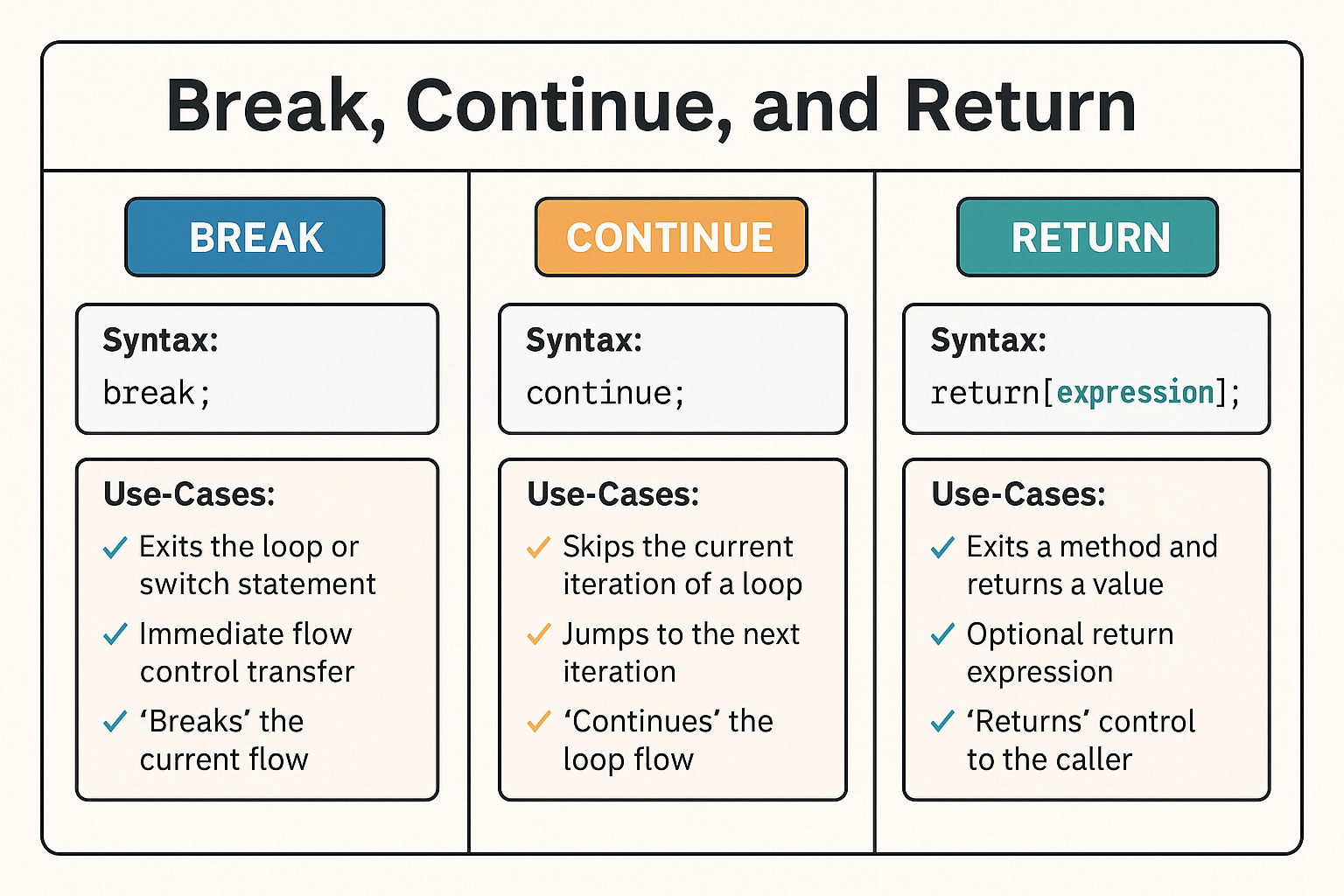Break, Continue, and Return in Java – Flow Control and Use-Cases
Flow control statements in Java allow developers to alter the normal execution path of programs. Among them, break, continue, and return are powerful tools used in loops and methods to manage execution flow efficiently.
🔍 Why are Break, Continue, and Return Important?
- Provide better control over loop execution.
- Improve code readability and reduce unnecessary iterations.
- Allow early exit from methods and blocks when conditions are met.
- Essential for implementing efficient algorithms and state handling.
✅ break Statement
The break statement immediately exits the nearest enclosing loop or switch statement.
✅ Syntax:
break;
✅ Example: Exiting a Loop
for(int i = 1; i <= 10; i++) {
if(i == 5) {
break; // Exit loop when i equals 5
}
System.out.println("Value: " + i);
}
✅ Use-Cases:
- Exiting loops early when condition is met.
- Ending switch-case execution.
✅ continue Statement
The continue statement skips the current iteration and moves to the next iteration of the loop.
✅ Syntax:
continue;
✅ Example: Skipping Values
for(int i = 1; i <= 5; i++) {
if(i == 3) {
continue; // Skip value 3
}
System.out.println("Value: " + i);
}
✅ Use-Cases:
- Skipping specific values during iteration.
- Improving performance by avoiding unnecessary computation.
✅ return Statement
The return statement ends the execution of a method and optionally returns a value.
✅ Syntax:
return; // For void methods
return value; // For methods with a return type
✅ Example: Returning Early
public int findPositive(int[] arr) {
for(int num : arr) {
if(num > 0) {
return num; // Return first positive value
}
}
return -1; // Default return if none found
}
✅ Use-Cases:
- Exiting a method early when a result is found.
- Returning computed values from methods.
🔄 Performance & When to Use
- break: Efficiently exits loops when no further processing is needed.
- continue: Reduces unnecessary computation by skipping unwanted iterations.
- return: Stops method execution immediately, reducing overhead.
🚫 Common Mistakes
- Using
breakoutside loops or switch (causes compile error). - Misusing
continueleading to infinite loops. - Forgetting to return a value in non-void methods.
💡 Tips & Best Practices
- Use
breakto avoid nested if conditions in loops. - Use
continuefor cleaner filtering logic inside loops. - Use
returnwisely for early exits; avoid multiple return statements unless improving clarity.
🧠 Interview Relevance
-
Q: Difference between break and return?
-
A: break exits loops/switch; return exits methods.
-
Q: Can we use break with labels?
-
A: Yes, labeled break can exit outer loops in nested structures.
🧩 Java Version Relevance
| Java Version | Feature |
|---|---|
| Java 1.0 | Introduced break, continue, and return |
| Java 1.5+ | Enhanced for-loops support with break/continue |
✅ Summary
- break: Exit loops or switch immediately.
- continue: Skip current iteration and move to the next.
- return: Exit method execution and optionally return a value.
